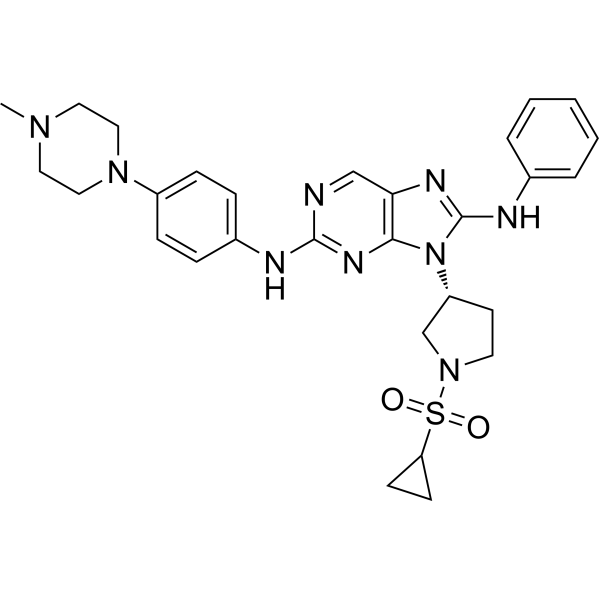Physicochemical Properties
| Molecular Formula | C29N9O2SH35 |
| Molecular Weight | 573.7123 |
| Exact Mass | 573.26 |
| Elemental Analysis | C, 60.71; H, 6.15; N, 21.97; O, 5.58; S, 5.59 |
| CAS # | 2463200-44-2 |
| PubChem CID | 145712397 |
| Appearance | White to yellow solid powder |
| LogP | 3.7 |
| Hydrogen Bond Donor Count | 2 |
| Hydrogen Bond Acceptor Count | 10 |
| Rotatable Bond Count | 8 |
| Heavy Atom Count | 41 |
| Complexity | 971 |
| Defined Atom Stereocenter Count | 1 |
| SMILES | N1(CCN(C)CC1)C1C=CC(=CC=1)NC1=NC2N([C@@H]3CCN(C3)S(=O)(=O)C3CC3)C(NC3C=CC=CC=3)=NC=2C=N1 |
| InChi Key | RNEHWYIFHKBZAW-XMMPIXPASA-N |
| InChi Code | InChI=1S/C29H35N9O2S/c1-35-15-17-36(18-16-35)23-9-7-22(8-10-23)31-28-30-19-26-27(34-28)38(29(33-26)32-21-5-3-2-4-6-21)24-13-14-37(20-24)41(39,40)25-11-12-25/h2-10,19,24-25H,11-18,20H2,1H3,(H,32,33)(H,30,31,34)/t24-/m1/s1 |
| Chemical Name | (R)-9-(1-(cyclopropylsulfonyl)pyrrolidin-3-yl)-N2-(4-(4-methylpiperazin-1-yl)phenyl)-N8-phenyl-9H-purine-2,8-diamine |
| Synonyms | EGFR-IN-11; RXN00442; RXN-00442; RXN 00442; |
| HS Tariff Code | 2934.99.9001 |
| Storage |
Powder-20°C 3 years 4°C 2 years In solvent -80°C 6 months -20°C 1 month |
| Shipping Condition | Room temperature (This product is stable at ambient temperature for a few days during ordinary shipping and time spent in Customs) |
Biological Activity
| Targets | EGFRL858R/T790M/C797S 18 nM (IC50) |
| ln Vitro | EGFR-IN-11 (Compound D9; 0.0001-10 µM; 72 hours) exhibits a highly effective inhibitor of HCC827 and H1975 cell lines, with IC50 values of 0.88 nM and 0.20 µM, correspondingly[1]. EGFR-IN-11 (0.01 EGFR-IN-11 1 µM) inhibits the phosphorylation of EGFR in the HCC827, H1975, and A549 cell line in a concentration-dependent manner[1]. Potently inducing apoptosis in HCC827 cells, EGFR-IN-11 (1 µM; 24 h) also causes cell cycle arrests in HCC827 cells[1]. |
| Cell Assay |
Cell Proliferation Assay[1] Cell Types: Human lung cancer cell lines HCC827 (EGFRDel E746-A750), H1975 (EGFRL858R/T790M) and A549 (EGFRWT); epidermoid carcinoma cell line A431 (EGFRWT) Tested Concentrations: 0.0001, 0.0003, 0.001, 0.003, 0.01, 0.1, 1, 10 µM Incubation Duration: 72 hrs (hours) Experimental Results: Inhibited HCC827 H1975 A549 cells proliferation with IC50s of 0.88±0.09 nM, 0.20±0.01 μM, 2.91 ±0.61 μM, and >10 μM, respectively. Western Blot Analysis[1] Cell Types: HCC827, H1975 and A549 cells Tested Concentrations: 1.00, 0.10 and 0.01 µM for HCC827 cells; 10.00, 1.00 and 0.10 µM for H1975 and A549 cells Incubation Duration: 8 hrs (hours) Experimental Results: Suppressed EGFR phosphorylation in a concentration-dependent manner. EGFR phosphorylation in the HCC827 cell line was more remarkably suppressed than in the H1975 and A549 cell lines. Apoptosis Analysis[1] Cell Types: HCC827 cells Tested Concentrations: 1 µM Incubation Duration: 24 hrs (hours) Experimental Results: The percentages of apoptotic cells is 56.91%. Cell Cycle Analysis[1] Cell Types: HCC827 cells Concen |
| References |
[1]. Discovery of novel 9-heterocyclyl substituted 9H-purines as L858R/T790M/C797S mutant EGFR tyrosine kinase inhibitors. Eur J Med Chem. 2019 Nov 16:111888. |
Solubility Data
| Solubility (In Vitro) | DMSO : 125 mg/mL (217.88 mM) |
| Solubility (In Vivo) |
Solubility in Formulation 1: ≥ 2.08 mg/mL (3.63 mM) (saturation unknown) in 10% DMSO + 40% PEG300 + 5% Tween80 + 45% Saline (add these co-solvents sequentially from left to right, and one by one), clear solution. For example, if 1 mL of working solution is to be prepared, you can add 100 μL of 20.8 mg/mL clear DMSO stock solution to 400 μL PEG300 and mix evenly; then add 50 μL Tween-80 to the above solution and mix evenly; then add 450 μL normal saline to adjust the volume to 1 mL. Preparation of saline: Dissolve 0.9 g of sodium chloride in 100 mL ddH₂ O to obtain a clear solution. Solubility in Formulation 2: ≥ 2.08 mg/mL (3.63 mM) (saturation unknown) in 10% DMSO + 90% Corn Oil (add these co-solvents sequentially from left to right, and one by one), clear solution. For example, if 1 mL of working solution is to be prepared, you can add 100 μL of 20.8 mg/mL clear DMSO stock solution to 900 μL of corn oil and mix evenly. (Please use freshly prepared in vivo formulations for optimal results.) |
| Preparing Stock Solutions | 1 mg | 5 mg | 10 mg | |
| 1 mM | 1.7430 mL | 8.7152 mL | 17.4304 mL | |
| 5 mM | 0.3486 mL | 1.7430 mL | 3.4861 mL | |
| 10 mM | 0.1743 mL | 0.8715 mL | 1.7430 mL |
